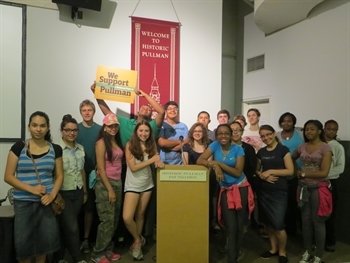
Photo by Robert Shymanski, Historic Pullman Foundation
A national park in Pullman would preserve the neighborhood's iconic building stock.
 By LeAaron Foley, Midwest Senior Outreach Coordinator, National Parks Conservation Association
By LeAaron Foley, Midwest Senior Outreach Coordinator, National Parks Conservation Association - August 5, 2013
Name one national park in Chicago. Having a difficult time? That’s because Chicago doesn’t have any national parks. However, that could soon change due to the diligent efforts of a growing group of supporters. The National Parks Conservation Association (NPCA), along with several community groups on Chicago’s South Side, is working to establish the Pullman Historic District as Chicago’s first national park. Pullman’s uniquely American stories of industry, urban planning, African American and labor history make it a true national treasure.
As Chicago’s first national park, Pullman presents opportunities in some unexpected ways. There will certainly be more visitors spending more money in the area. The National Parks Conservation Association has commissioned an economic report to be released this fall that will quantify job creation, visitor spending, and other impacts to the neighborhood when Pullman becomes a national park. Among those impacts, we expect that building renovation of historic Pullman row houses will grow, visitor services like restaurants and small shops will pop up and other tourism-related services, such as trolleys, could be established.

Existing community groups can benefit from a strong, mutually beneficial relationship with the National Park Service.
Historic Pullman Foundation
National parks in urban areas have strong connections with local community groups and these partnerships are especially important when the federal budget is tight. The National Park Service has already been to Pullman and has met with many existing civic and community groups in an effort to learn about the great work being done in the neighborhood. The groups that hold events, give walking tours, renovate historic buildings and generally make Pullman a great place to live will continue doing what they do best with the added benefit of having a “new neighbor” that brings additional expertise and commitment to the community.
Pullman is easily accessible by train and is served by several bus routes. But the 111th Street/Pullman Metra station will need drastic improvement to support the projected 350,000 visitors a year that a Pullman National Historical Park could attract. Pullman could easily become a hub linking the neighborhood to the rest of the region through existing and planned trails and bike lanes. A national park at Pullman will help drive the demand to improve access.
Urban national parks such as Lowell National Historical Park in Lowell, Massachusetts; Cuyahoga Valley National Park in Cleveland; and Golden Gate National Recreation Area in San Francisco are valuable assets to the metro regions in which they are located attracting infrastructure improvements to roads and viaducts, bike share stations and federal funding for trolleys, energy-efficient lighting and historic building renovation. And at Lowell, hundreds of artist work/live studios have recently been developed in a historic building within the national historical park.

The Pullman Porters were representative of the African American middle class.
Pullman State Historic Site
Imagine the possibility of breathing life into the Pullman clock tower building; or boosting renovation in the entire neighborhood; or seeing national park visitors driving demand for stores and restaurants. Pullman is an important piece of American history and establishing a national park here will ensure the many stories of labor history, the rise of the African-American middle class and access to this beautiful neighborhood will be preserved unimpaired for future generations.
If you’re interested in supporting the effort to establish Pullman as Chicago’s first national park, go here to sign-on your support: http://www.npca.org/about-us/regional-offices/midwest/sign-on-letter-for-pullman.html